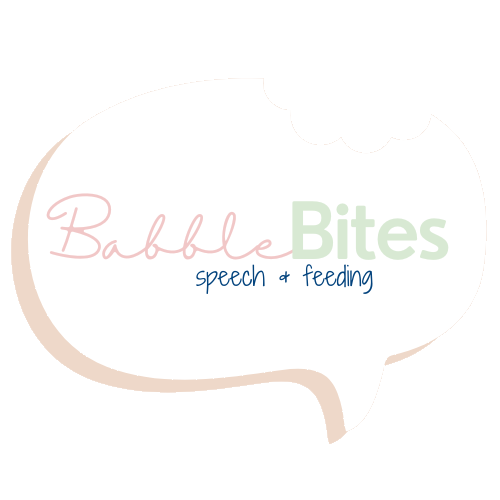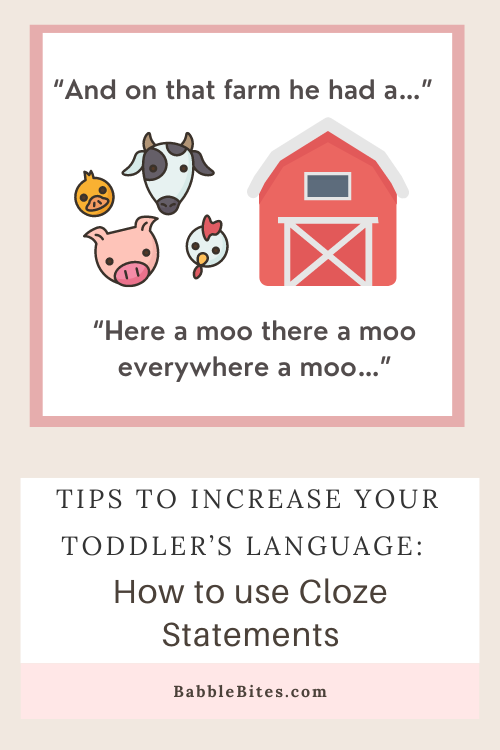Tips to Increase Your Toddler’s Language: How to use Cloze Statements
What are cloze statements?
“It’s raining cats and…”
“Break me off a piece of that…”
“Row row row your…”
Did your brain automatically fill in the words “dogs,” “Kit-Kat bar,” and “boat”? This is the power of cloze statements! Cloze statements, or sentence completion tasks, use a familiar sentence and require the listener to fill in the last word, like a fill in the blank.
Why do cloze statements help improve language development?
Cloze statements can be used to encourage your little one to participate in singing songs, reading books, and making comments about routine tasks. When we take a sentence, song, or phrase that is very familiar to us (we’ve heard it repeated many times), our brain starts to automatically fill in the words. Many times when I use this strategy in therapy sessions, I notice that parents can’t help themselves but to fill in the word when I pause and wait for their child to fill in a word of a familiar song or phrase! This is because it is such an automatic response for our brains when this pause occurs, and the same reason it’s such an effective strategy to help increase your toddler’s use of words. When we intentionally leave off the last word of one of these familiar phrases or sentences, and pause while looking expectantly at our child, it encourages them to try to fill in the word for us. This helps them participate verbally in tasks like singing and reading that they might not do yet on their own without us (the adult) creating an opportunity for them to use their words. Overall, this strategy helps increase your child’s self-confidence and motivation with their use of words, and teaches turn taking in speaking. Keep reading to learn how to use this strategy, and some examples you can incorporate into your daily routines!
Singing a familiar song is a great opportunity to try out the cloze statement strategy.
How do you use cloze statements to improve your toddler’s language?
To use cloze statements, or sentence completion, with your child, we can use any repetitive or familiar song, repetitive or familiar books, and daily verbal routines. It is best to use this strategy with a child who is starting to use some words independently (i.e. saying some words on their own, without having to hear it modeled first). After your child has been exposed to the song, book, or verbal routine many times, you can start using this strategy! Songs and books your child is highly motivated by and interested in are great ones to start with.
Say the familiar phrase or sentence, and then intentionally leave off the last word while you pause and look at your child expectantly (eyebrows raised, smiling with mouth slightly open as if you are about to say a word, making eye contact). For example, “The horn on the bus goes…” Wait up to five seconds before filling in the word for your child if they do not yet fill it in on their own. You can also try giving a visual cue (e.g. doing the hand motion for ‘beep’), or a phonemic cue (i.e. saying the first sound of the targeted word, e.g. “b” for beep), before filling in the word for your child.
At first, your child may just vocalize (e.g. “eh,” “bah”), indicating they know you are waiting for them to say something, they just aren’t sure of the word yet. This is still great practice! Encourage them for their communication attempt, model the word for them, and keep practicing with other familiar phrases!
If you’re concerned about your child’s speech or language development, talk to your pediatrician and get a referral for a speech-language evaluation.
Reading a familiar story is another great opportunity to use the cloze phrase strategy.
Cloze statement examples:
Songs:
“The Wheels on the Bus”
“The wheels on the bus go…”
Or try it on the second repetition so they hear is modeled first
“The horn on the bus goes beep beep beep, beep beep beep, beep beep beep, the horn on the bus goes…”
“The people on the bus go…”
“Old McDonald”
“And on that farm he had a…” (tip: hold up an animal for your child to label, or two animals for your child to choose from)
“Here a ba there a ba everywhere a ba…”
“E, I, E, I…”
“Twinkle Twinkle Little Star”
“How I wonder what you…”
“Up above the world so…”
“Like a diamond in the…”
“The Itsy Bitsy Spider”
“Down came the rain and…”
“Out came the…”
“And the itsy bitsy…”
Books:
“Brown Bear, Brown Bear, What Do you See”
“Green frog green frog what do you…”
“White dog, white…”
“I see a red bird looking at…”
“Five Little Monkeys Jumping on the Bed”
“Five little monkeys jumping on the…”
“One fell off and bumped his…”
“Mama called the doctor and the doctor said…”
”We’re Going On A Bear Hunt”
“We’re going on a bear…”
“We’re going to catch a big…”
“What a beautiful…”
“We’re not…”
“Little Blue Truck”
“Little blue truck came down the…”
“‘Beep’ said Blue to a big green…”
“Sheep said…”
“‘Oink’ said a…”
“‘Maaa’ said a goat, Blue said…”
“Pete the Cat: I Love My White Shoes”
“I love my white…”
“Pete stepped in a large pile of…”
“Did Pete cry? Goodness…”
Verbal Routines:
“Ready, set…” “go”
“Shoe…” “on”
“Sock…” “on”
“Lights…” “off”
“Night night mama, night night…” “dada”
“Byebye blue block, byebye green…” “block”
“Knock knock knock, open the…” “door”
If you liked this post, share on Pinterest!



